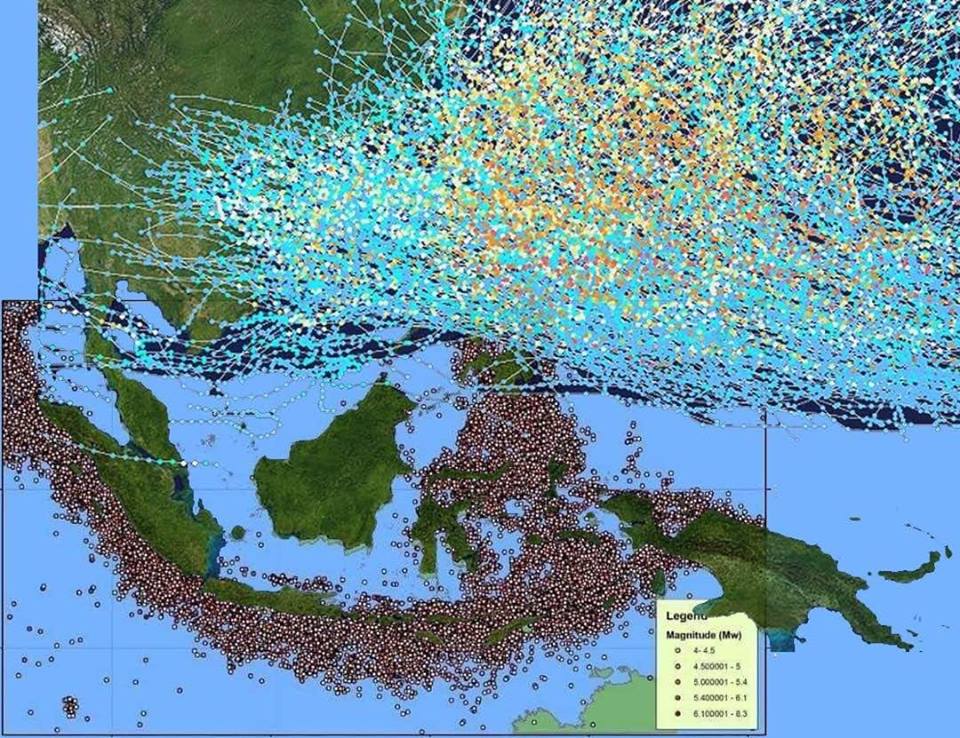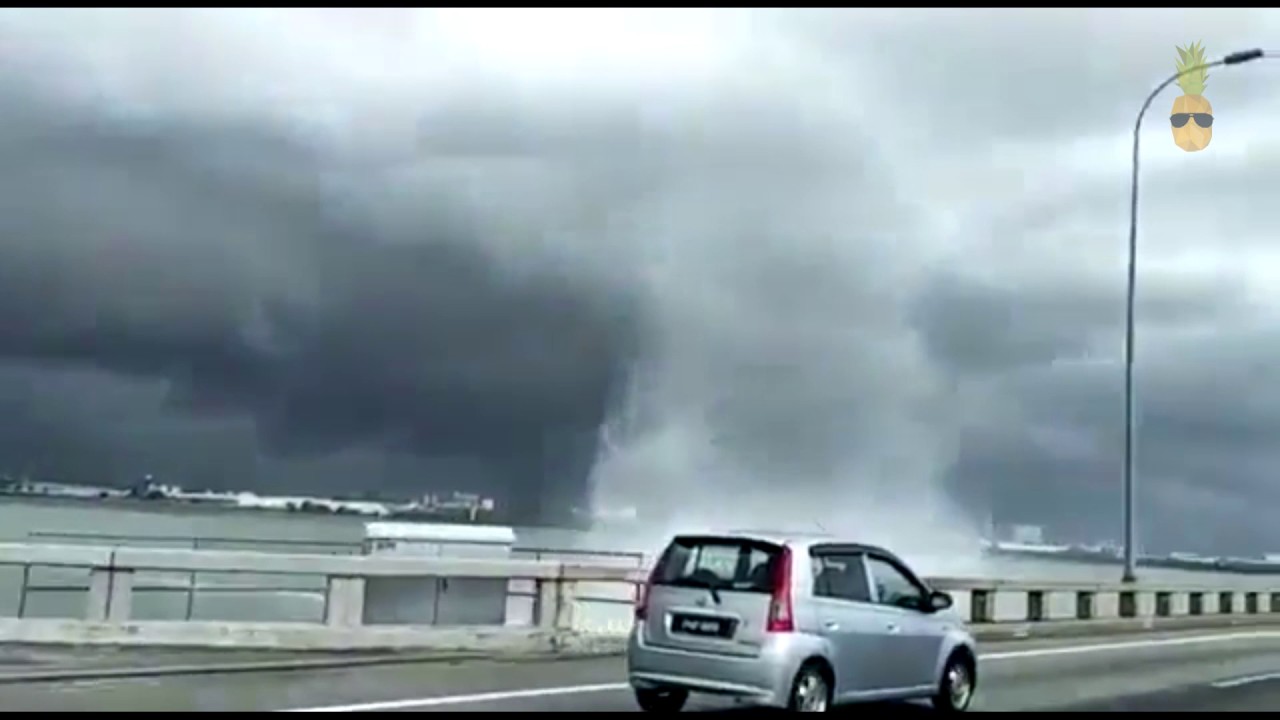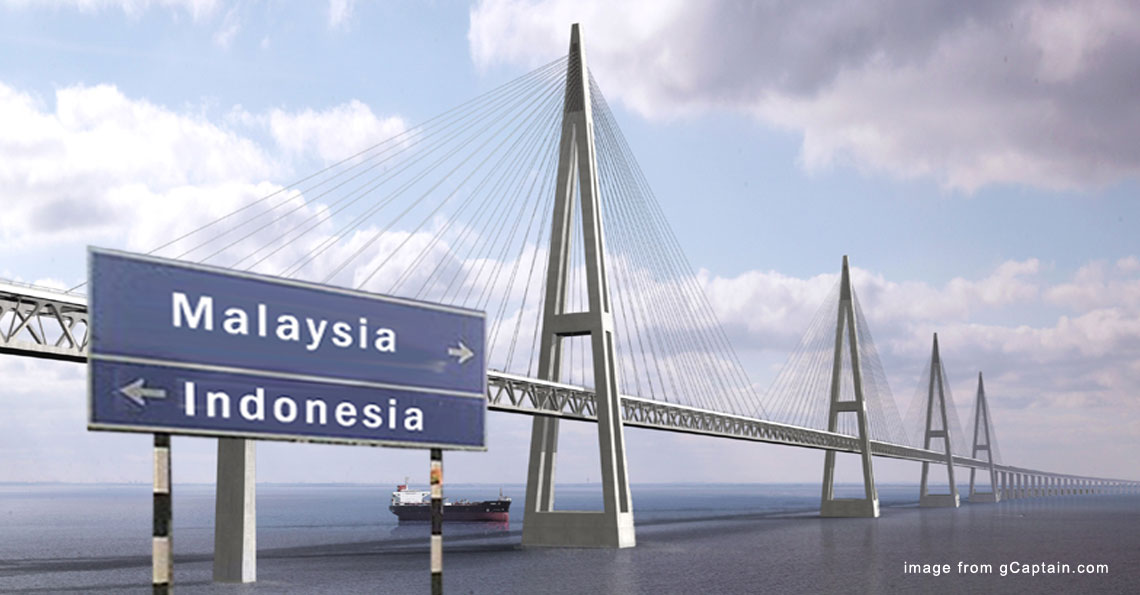What protects Malaysia from all these natural disasters that are happening in Indonesia?

- 22.0KShares
- Facebook21.5K
- Twitter42
- LinkedIn66
- Email81
- WhatsApp292
(Ed’s note: This article was originally translated and published on August 25th, 2018. It has been updated in light of the tragic Sept 2018 earthquake in Palu, Indonesia, and the Dec 2018 tsunami at the Sunda Strait.)
Oh no. Indonesia just had another devastating earthquake few months ago (1st October 2018). Our neighbours suffered a 7.5 magnitude quake + tsunami, and as of time of writing, over 1,200 people have been confirmed DEAD. And just a few days ago, while the world got ready to celebrate Christmas, residents around the Sunda Strait lost lives at the hand of a tsunami that came without warning. There was no earthquake this time round, but an eruption of the Anak Krakatau volcano which may have caused an undersea landslide.
This brings us back to a series of photos which made its rounds on Malaysian social media sometime in October:




This is totally relatable, because just few months ago when Malaysians were bickering about the Council of Eminent Persons, Dr M’s plans for public transport, a migrant worker scandal, and even a… um… a Kelantan university using science to understand genies, Indonesians had just started getting hit by a series of earthquake – the first being a 6.4 magnitude quake on 29th July 2018. It killed 14 people including a Malaysian. Siti Nur Ismawida was reportedly crushed by a pillar of a homestay where she stayed. 🙁

The earthquake didn’t just hit Lombok. A week after the first quake, Lombok was hit again with yet another quake but, this time around, it shook Bali as well. So that got us wondering…
Malaysia is SOOO close to Indonesia… so why we tak kena earthquake one?
Before that, let’s have a 101 on how earthquakes happen. We’ve actually written something about this waaaaay back then but let’s just refresh, okay?
Basically, the earth is made up of several large broken pieces called the Tectonic plates. Just imagine them like puzzle pieces:

But unlike your nerdy friend’s anime puzzle hanging on his wall, these tectonic plates actually MOVE a few centimeters every year. It’s actually caused by heat, as these plates are close to the mantle of the earth (one of earth’s layer btw). If you look closely in the picture above, you would find that these plates have boundaries. Quakes are caused by the collision of these boundaries or when they get stuck to each other.
And that’s precisely what just happened in Lombok – Australian tectonic plates had moved on top of Indonesian islands.
Hold up, wouldn’t that mean Malaysia would feel tremors when Indonesia get hit by an earthquake since both countries are at the edge of the border? Well… We’re very lucky in the sense that Malaysia isn’t located on the Ring of Fire (the hotspot for earthquakes and volcanic eruptions). About 90% of earthquakes and 75% (which is like 452) active volcanoes are situated in that area.
Indonesia on the other hand… isn’t so lucky. They’re ON the Ring of Fire, and that’s why we keep seeing news headlines about earthquakes there.

Waah so lucky la Malaysians! But actually we also kena other things
(This section heavily refers to an interview between a Mingguan Malaysia’s journalist and Professor Madya Mustaffa Kamal Shuib, a lecturer at the Geology Department in Universiti Malaya)
Not to downplay Indonesia’s fate, but just to highlight that although we’re out of the ring, that doesn’t mean it’s all sunshine and rainbows over here.
The sucky thing about earthquakes isn’t just the grounds breaking, buildings collapsing… but the fact that earthquakes also cause TSUNAMIS. An earthquake in one country can send tremors across the continents, causing motherfreakin waves taller than KL Tower! This is all too familiar to us, as the massive Aceh earthquake of 2004 caused tsunami in various countries, including ours, and left almost 200,000++ dead.
As we mentioned earlier, Malaysia’s location is a bit off from the Ring of Fire which means we’re protected from natural disasters like earthquakes and volcanic eruptions. As a matter of fact, Prof Madya Mustaffa Kamal mentioned how Malaysia is also located outside of the pathway of hurricanes, hence, why we don’t really have tornadoes in Malaysia.

However, we should be wary since Malaysia can be affected by the compression energy formed by neighbouring countries on the Ring of Fire. The energy may be hard to penetrate into Malaysia, but, if it does, Malaysia may experience a minor quake, something around 3.5 magnitude quake. If it happens, it would be the largest quake to ever happen in Peninsula. (For comparison, the 2015 Sabah quake, which affected climbers at Mount Kinabalu, was a 6.0.)
This was what happened during Aceh’s quake in 2004. It was so massive that the energy, which was released bit by bit, caused small tremors in Peninsula Malaysia.
“In my opinion, it is better if the energy is released through small-scaled tremors because if it is collected and only released in one earthquake incident, then a large-scaled earthquake would be formed and this would put us all in danger.”- Prof Madya Mustaffa Kamal, for Utusan.
But there were also times where Malaysia experienced internal quakes (aka quakes that weren’t caused by other countries), like the 2015 Sabah quake where the centre of the quake was right under Mount Kinabalu. We actually covered this story and ugaiz can read more here.

According to Prof Madya Mustaffa Kamal, Sabah has THREE red zones (active); the middle zone, Sandakan and Semporna. Meanwhile, there are areas categorised as black zones aka areas where quakes are no longer active. It may be hard for quakes to happen in Sabah as incidents like this only happen once in 25 years. But it may not happen in the near future as the tremors were said to have eventually reduced.
It was reported that Sabah has experienced mini quakes for almost 80 times especially in Lahad Datu since the 60s. But this doesn’t prove that Sabah is the only state prone to quakes, as there were several others that suddenly happened in the Peninsula Malaysia –
- Janda Baik, Pahang (November 2007)
- Jerantut, Pahang (March 2009)
- Manjung, Perak (29 April 2009)
- Kuala Pilah, Negeri Sembilan (November 2009)
We were actually fortunate since they didn’t exceed 3.5 magnitude. If that were to happen, gone lah our buildings. Sure hancur to some extent.
But earthquakes aren’t the only thing tectonic plates create in Malaysia.
Malaysia has volcanoes too, thanks to those plates! But they’re calm volcanoes.
Prof Madya Mustaffa Kamal says that in Peninsula Malaysia, there are volcanoes in Kuantan (the youngest and final volcano to erupt in this country), Segamat, Gerik and Gua Musang! We had no idea Johor got volcano wtfbbqptptn?! Anyway, these areas contained volcanic stones caused by the eruptions of volcanoes a long time ago. Wait, there’s more. There are also traces of volcanoes in Semporna and Tawau. A volcanic crater was said to remain in Tawau but it’s been a while since it was last active.
“It is true that there were several places in Malaysia that had volcanoes but the eruptions happened 100 million years ago. So, what’s left today are only the remaining of the volcanoes that has been dead.” – Prof Madya Mustaffa Kamal, excerpt from Utusan.

But… how come there are volcanoes in Malaysia?
Tectonic plates actually create more than just natural disasters like earthquakes and tsunamis. Some of the boundaries of these plates collide but would eventually stop at one point. This type of collision forms mountains. As a matter of fact, the Himalayas were formed by the collision of the Indo-Australian Plate with the Eurasian Plate!
Aside from mountains, these plates are able to form volcanoes. Imagine someone very nottie just punch you in the stomach after you eat. Of course you would end up vomiting whatever you just ate, right? Similar to that, the tectonic plates that collide would vomit the earth’s magma which would be erupted through the cracks on the surface of the earth.

Fortunately, volcanoes in Malaysia are no longer active due to the process of erosion and deposition which took place a million of years ago. So, we don’t need to worry much about these volcanoes lah! 😉 But…
Malaysians may still need to acquire the knowledge on security measures for disaster
… and not for the reasons you think. Experts say that there are two main concerns for Malaysians – sinkholes, and damages to building structures from underground tremors.

Therefore, it may be important for Malaysians to acquire the knowledge of security measures when natural disaster happens.
Considering that these two things aren’t exactly uncommon, (heck, remember the massive hole at Bukit Bintang on top?!) it REALLY wouldn’t be a bad idea for Malaysians to know what to do before mother nature gets nasty on us.
Nah don’t say Cilisos never teach. Some basic knowledge on security measures would be:
- If you’re in a building when an earthquake happens, you should stay indoors and take shelter under a table (a stable one lah),
- If you’re far from any tables, you could go to a corner of the building or near the door
- Choose a location with good airflow that allows you to breathe and avoid from staying close to windows and other heavy objects
- Don’t use candles, matches or anything flammable as there may be possibility of gas leaking
- Don’t rush outside of the building and other security measures.
But most importantly, you should not panic when this happens. With all these knowledge, it may help Malaysians to be aware and prepared to face any natural disaster.
- 22.0KShares
- Facebook21.5K
- Twitter42
- LinkedIn66
- Email81
- WhatsApp292



